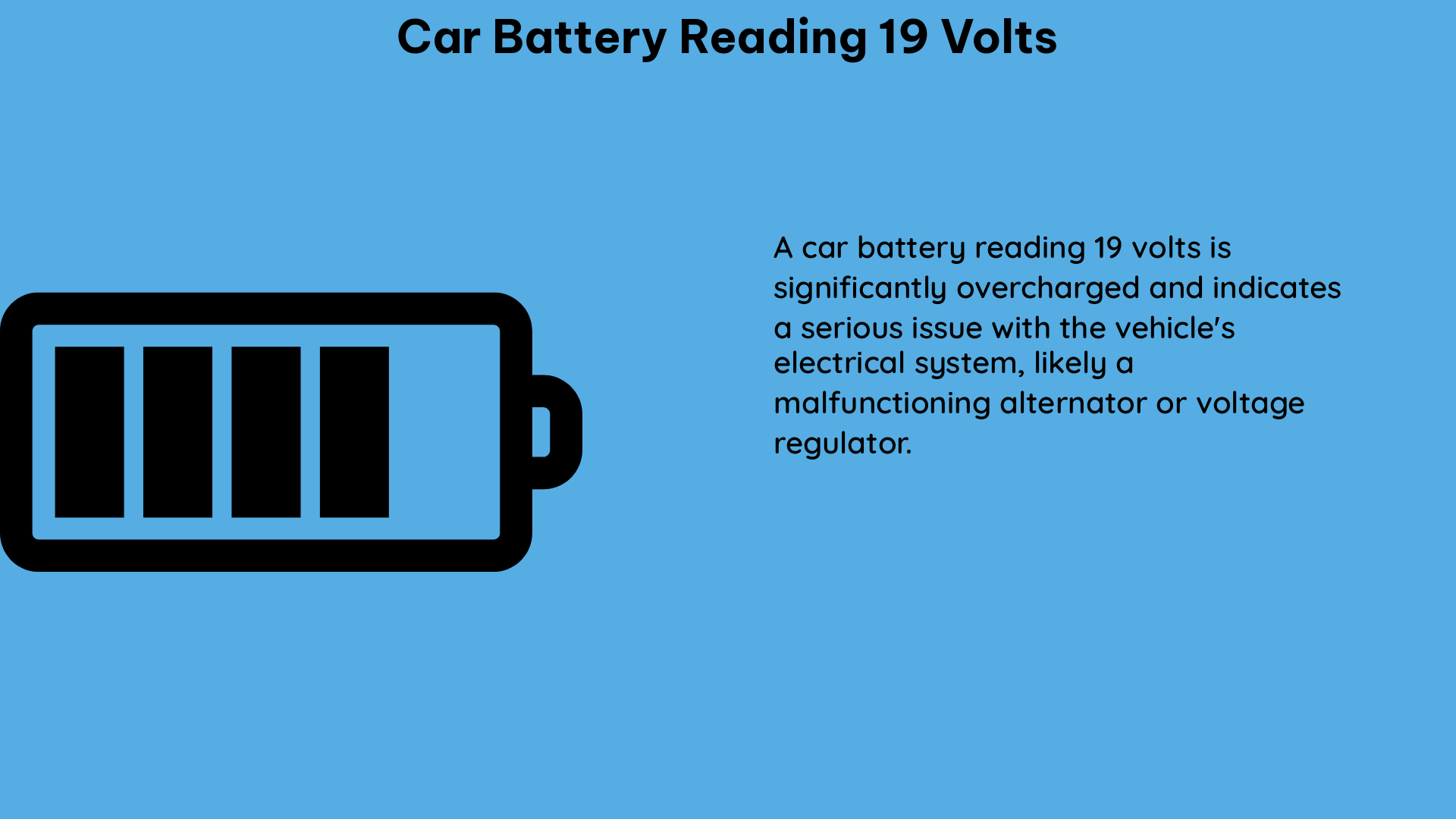A car battery reading 19 volts is a clear indication of an issue within the vehicle’s electrical system. This abnormally high voltage can be caused by various problems, including a malfunctioning alternator, voltage regulator, or even a faulty battery. As an expert on car batteries, I’ll provide a comprehensive guide to help you diagnose and resolve this problem effectively.
Understanding the Normal Battery Voltage Range
Before delving into the specifics of a 19-volt reading, it’s essential to understand the typical voltage range for a healthy car battery:
- Fully Charged Battery (Engine Off): Approximately 12.66 volts
- Charged Battery (Engine Running): Around 13.8 volts
- Discharged Battery (Engine Off): Below 12.6 volts
A battery reading 19 volts is significantly higher than the normal range, indicating an overcharging issue within the electrical system.
Diagnosing the Cause of the High Voltage

To pinpoint the root cause of the 19-volt reading, you’ll need to perform a series of tests and inspections. Here’s a step-by-step guide:
1. Confirm the Voltage Reading
- Use a digital multimeter to measure the voltage at the battery terminals, ensuring the reading is indeed 19 volts.
- Verify the reading by checking the voltage at different points in the electrical system, such as the alternator output and the voltage regulator.
2. Inspect the Battery Terminals and Connections
- Examine the battery terminals for signs of corrosion or damage.
- Clean the terminals and connections using a wire brush or baking soda and water solution.
- Ensure the connections are tight and free of any loose or damaged wiring.
3. Test the Alternator
- The alternator is responsible for charging the battery and maintaining the electrical system’s voltage.
- Use a multimeter to test the alternator’s output voltage while the engine is running.
- The alternator should be producing a voltage between 13.5 and 14.5 volts.
- If the alternator is producing a voltage higher than 14.5 volts, it may be the root cause of the 19-volt reading.
4. Evaluate the Voltage Regulator
- The voltage regulator controls the alternator’s output voltage to prevent overcharging.
- If the voltage regulator is malfunctioning, it can allow the alternator to produce an excessively high voltage, leading to the 19-volt reading.
- Test the voltage regulator by disconnecting it from the alternator and measuring its output voltage.
5. Check for Wiring Issues
- Inspect the wiring between the battery, alternator, and voltage regulator for any signs of damage, corrosion, or loose connections.
- Ensure all the wiring is in good condition and properly secured.
6. Consider Battery Replacement
- If the battery is old or showing signs of wear, it may be contributing to the high voltage reading.
- Replace the battery if it is not holding a charge or exhibiting other issues.
Resolving the High Voltage Issue
Once you’ve identified the root cause of the 19-volt reading, you can proceed with the necessary repairs or replacements:
-
Alternator Replacement: If the alternator is found to be the culprit, replace it with a new, properly functioning unit.
-
Voltage Regulator Replacement: If the voltage regulator is malfunctioning, replace it to restore the proper voltage regulation.
-
Wiring Repairs: Address any issues with the wiring, such as corrosion, damage, or loose connections, to ensure the electrical system is functioning correctly.
-
Battery Replacement: If the battery is old or damaged, replace it with a new, high-quality battery.
-
Professional Diagnosis: If the issue persists or you’re unsure of the root cause, it’s recommended to consult a professional mechanic for further diagnosis and repair.
Preventive Maintenance
To avoid future issues with high battery voltage, consider the following preventive maintenance steps:
- Regular Battery Inspections: Periodically inspect the battery terminals and connections for signs of corrosion or damage.
- Alternator and Voltage Regulator Testing: Have the alternator and voltage regulator tested during routine maintenance to ensure they are functioning correctly.
- Electrical System Checkups: Include a comprehensive electrical system inspection as part of your vehicle’s regular maintenance schedule.
By following this comprehensive guide, you’ll be well-equipped to diagnose and resolve the issue of a car battery reading 19 volts, ensuring the proper functioning of your vehicle’s electrical system.
References:
- Jeep Forum Thread: Battery Gauge at 19V and Check Gauge Light On
- Clio Sport Thread: Alternator Died and Battery is Reading 19Volts – Any Ideas?
- Drive Accord Thread: Battery Reading 19V
- Corral.net Thread: Battery Voltage 19.0V – Why?
- Expedition Forum Thread: Alternator/Battery 19V Reading

The lambdageeks.com Core SME Team is a group of experienced subject matter experts from diverse scientific and technical fields including Physics, Chemistry, Technology,Electronics & Electrical Engineering, Automotive, Mechanical Engineering. Our team collaborates to create high-quality, well-researched articles on a wide range of science and technology topics for the lambdageeks.com website.
All Our Senior SME are having more than 7 Years of experience in the respective fields . They are either Working Industry Professionals or assocaited With different Universities. Refer Our Authors Page to get to know About our Core SMEs.